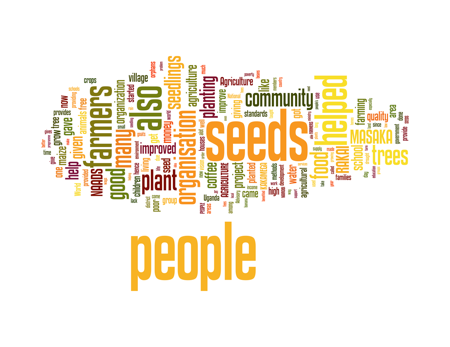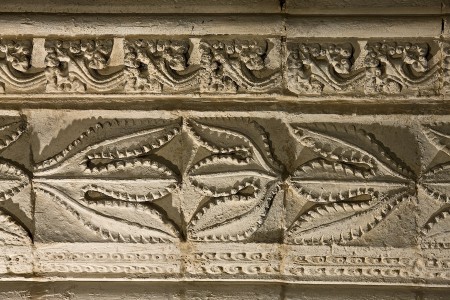- Shipwreck offers insights into agricultural trade in Turkey 1500 years ago.
- Coffee from alpha to omega.
- Drought-resistant crops for East Africa. Well, yes. And more specifically…
- “African” crops in America.
- Program to focus on making better use of vegetables. And that “program” has been going since 1986! Who knew?
- Why we should all be taxonomists.
Lafort onion, and Wellesbourne, revisited
Chasing stuff down, because we can, sometimes results in (very mild) disappointment.
When I read about an onion called “Lafort (sourced originally from the Wellbourne [sic] gene bank and regenerated by Irish Seed Savers,” we not only Nibbled it, I also dropped a note to Irish Seedsavers asking for the full story. I had hoped that, despite the frenchified name, it might be a long-lost Irish onion kept at Wellesbourne and now repatriated. Alas, it seems not …
Here’s the story, lightly edited by me:
Wellesbourne told the Irish Seed Savers that Lafort comes from Norway originally. Michael Miklis (who was instrumental in re-locating and re-propagating the Irish heritage grain collection from his farm in Kilkenny from 1998-2001) met Dave Astley [then head of the genebank at Wellesbourne] in 1999, and asked whether Wellesbourne had the Irish onion variety Buan. (Irish Seed Savers did get seed of Buan from the Vavilov genebank.) Miklis also asked about any other onions that would mature early in a long-day environment. Dave spoke to a Wellesbourne onion breeder, who suggested selections from Norway that are generally early maturing. The original sample of seed came to Wellesbourne from the Royal Norwegian Society for Development.
And so to answer the question, it came to Irish Seed Savers from an interested party who was in all likelihood trying to expand the open-pollinated gene-pool for onions in this country, making sure that suitable breeding material existed here. At Irish Seed Savers we often have things in the fridge collection that contain little mysteries, from a previous era when things weren’t written down and recorded so much. Your enquiries have certainly helped us to shed more light on this particular onion. And in order to secure our seed stocks, we have a regeneration programme of sorts that has the advantage that all the extra seed that is produced, as a result of allowing a largish population [to] flower and seed together (to maintain its genetic breadth), becomes seed available to members and the public. We take our own sample of the seed, foil-packet it, both fridge and freezer it, and the rest is for gardeners and, we hope, seed-savers to grow themselves. Anything without much merit doesn’t generally make it to this stage, although that’s a different story…
Indeed it is, and I hope this encourages seed savers everywhere to document their trials and tribulations. Was Lafort the only Norwegian onion to pass muster in Ireland? And is it, indeed, Norwegian in origin?
Wellesbourne’s glorious past segues nicely into a (new?) page by Dr Charlotte Allender, Assistant Manager of what is now called the Genetic Resources Unit, where she “explains more about the unit and the aims it hopes to achieve”.
What is the importance of preserving the genetic history of crops?
Far from being a museum or a kind of sealed time capsule, the seed collections in Warwick Genetic Resources Unit are in constant use. Around one thousand sub-samples are retrieved from the cold room and sent out every year. The foil packs which leave the arctic environment of the cold store do so at the request of a variety of people and organisations. Seed is conserved and managed for research, plant breeding, education and development. It can therefore arrive in the laboratory of a researcher interested in the network of genes that control aspects of plant growth and development, or to the field station of a plant breeder wishing to add new variation to their breeding programme. Seed can also find use in exhibits at public attractions such as The Eden Project or in small scale crop improvement programmes carried out by groups of farmers in countries as diverse as France and India.
The way in which the collections are being used is evolving too. Technological advances in DNA sequencing mean that potentially hundreds of genomes can be analysed in a shorter time and at a fraction of the price than when the human genome was sequenced. Comparing genetic differences between plants with contrasting appearance, maturity time or disease resistance (or indeed any interesting trait) allows researchers to understand and identify the genes responsible, and through doing this channel them into new crop varieties more quickly than traditional plant breeding would allow. However, once the genetic analyses have been completed, and DNA sequences are safely stored, the seed itself will still be required to transfer the genetic diversity forward into the new varieties ultimately destined to end up on our plates.
Seed collections such as that housed in the Warwick Genetic Resources Unit are a vital resource in the quest to produce more food in a less environmentally damaging manner. Entering the cold room and breathing in the frigid air, it is easy sense the history sealed in each of the foil pouches, and to pause and contemplate the potential of the diversity held in a cold-induced sleep. But not for too long – it is, after all, very cold in there.
Long may it thrive. And provide seed.
Turning stories into data

We have a new time-waster to share. Global Giving, a meta-NGO we’ve raved about before, has just launched its globalgiving storytelling project. Why?
We’re trying to break through the self-report bias that often prevents international development from having a larger impact.
With this community-based beneficiary feedback we’re identifying community-focused organizations, good listeners, potential innovators, and we’re breaking through the self-report bias that often prevents international development from having a larger impact.
It will be interesting to see how this effort develops, and what uses are made of it. Meanwhile, it is easy to emerge from a rabbit-hole to find that half an hour has vanished from your life. We searched on “seed” to get the Wordle picture above. If you find any really great stories that deserve a wider audience, why not share them in a comment here?
Brainfood: Roots, Ethnopharmacology, Heat tolerance, Food origin myths, Trees outside forests, Wild fruit tree agroforestry, Viruses in genebank, Reintroduction
- Breeding crop plants with deep roots: their role in sustainable carbon, nutrient and water sequestration. Good for soil structure, good for C sequestration, good for yields. What’s not to like?
- Ethnopharmacology, food production, nutrition and biodiversity conservation: Towards a sustainable future for indigenous peoples. Ethnopharmacologists need to think more generally about nutrition, and a lot more about conservation. And a view on the whole “wonder herb” thing from two botanical garden boffins who protest way too much as far as I’m concerned.
- Modelling predicts that heat stress, not drought, will increase vulnerability of wheat in Europe. It’s the heat, not the humidity. But maybe wild relatives can help.
- The Virtuous Manioc and the Horny Barbasco: Sublime and Grotesque Modes of Transformation in the Origin of Yanesha Plant Life. Maize is the result of a virgin birth, chili peppers of a fart. I’ll buy that.
- Is there a forest transition outside forests? Trajectories of farm trees and effects on ecosystem services in an agricultural landscape in Eastern Germany. Yes, but.
- Biodiversity and socioeconomic factors supporting farmers’ choice of wild edible trees in the agroforestry systems of Benin (West Africa). Those factors are: how important the trees are for food and medicine and how accessible they are. Still no cure for cancer. Anyway, here’s what ICRAF thinks should come next: domestication, natch.
- Pome fruit viruses at the Canadian Clonal Genebank and molecular characterization of Apple chlorotic leaf spot virus isolates. There’s a lot of them. Well that can’t be good, can it?
- A long-term view of rare plant reintroduction. A previous review is way too pessimistic.
Corn conspiracy
I too am back from my summer holidays, but with a somewhat smaller haul of goodies. Two items only, and this is the first.
Take a look at this carving, part of the arch around a window in Rosslyn Chapel outside Edinburgh, more formally known as the Collegiate Chapel of St Matthew.
Do those things in the wider arch look to you like ears of maize?
And how about this? Do those stylised, possibly spiky three-leaved things look like an aloe, or, as the Rosslyn Chapel Photographic CD would have it, a cactus?
If they did, that would be a mystery indeed, because the chapel was completed in 1484, eight years before Columbus sailed to the New World, source of cacti and maize. There is, of course, a simple explanation: Henry I Sinclair, Earl of Orkney and grandfather of the Rosslyn Chapel’s founder, William Sinclair, sailed to North America in around 1398, brought back samples (or at least depictions) of maize and aloe (or cacti), which the chapel masons 1 incorporated into these carvings, all subsequent history of the incident being scrupulously hidden from history’s view.
Not having read or seen it, I was unaware that The Da Vinci Code makes much of Rosslyn Chapel and its Masonic and Templar associations, but frankly, I’m not in the least bit convinced that those carvings are what people say they are. And in that, I’m not alone. The BBC pours cold water on the idea too.
Undaunted, however, I’ll be scrutinizing the son-et-lumiere at Machu Pichu for evidence of neeps among the tatties.

